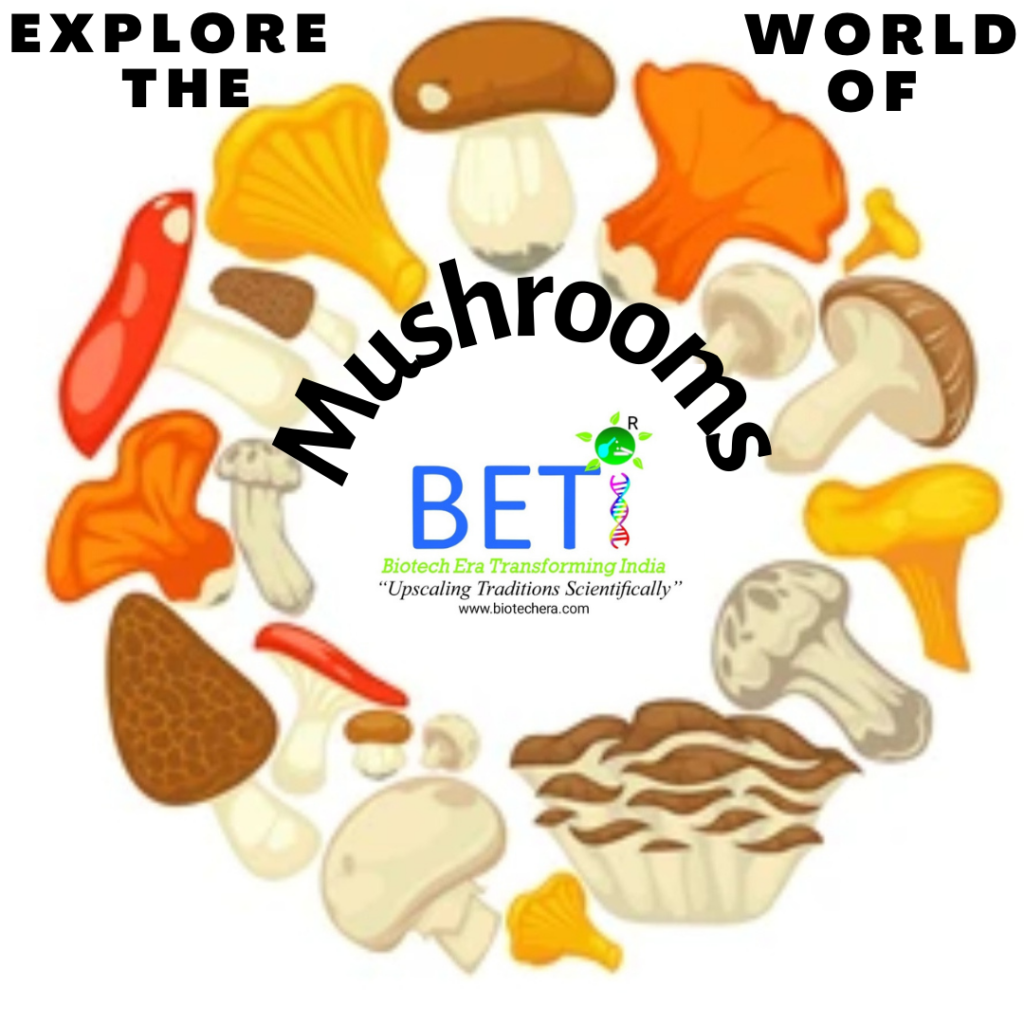“The greatest treasures are those invisible to the eye but found by the heart”-Judy Garland
Mushrooms are a staple ingredient in many kitchens and can be found in a variety of dishes. From soups and stews, to pizzas and salads, mushrooms are a versatile ingredient that can be used in a variety of ways. Whether you are a food enthusiast or just appreciate the nutritional benefits of mushrooms, joining the mushroom craze is a great way to add flavor and valuable nutrients to your daily menu. In this blog, we will explore the different varieties of mushrooms and how you can incorporate them into your daily life to enjoy their wonderful benefits.
Mushrooms are a unique type of fungi that grow on various substrates. They are diverse in terms of size, colour, shape, and taste. There are over 10,000 varieties of mushrooms in the world, with some being edible and others being dangerous. Here are some of the most popular varieties of mushrooms:
White Button Mushroom
One of the most commonly consumed mushrooms in the world is the white button mushroom. These mushrooms have a mild flavour and a spongy texture that pairs well with a wide range of dishes. They are also a good source of Vitamin D and Vitamin B. White button mushrooms, also known as Agaricus Bisporus, are the most commonly consumed mushroom in the world and are widely available in grocery stores and restaurants. They are native to Europe and North America and have a mild flavour and a firm texture.
CHARACTERISTICS
White button mushrooms have a round, firm cap with a smooth surface and a slightly curved stem. The cap is usually white and can range in size from small (about ¾ inches) to large (over 3 inches). It has a mild taste with a slightly earthy undertone. They can be eaten raw or cooked, and are often used as a base for sauces, soups, and stews. White button mushrooms are a good source of fiber, protein, and various vitamins and minerals such as Vitamin B6, Vitamin D, copper, and potassium. They are versatile in the kitchen and can be used in a variety of dishes, such as omelets, stir-fries, salads, and pasta dishes. They are also commonly used as a topping for pizzas and burgers.
Oyster Mushroom
Named for their distinctive shape, oyster mushrooms are popular in many Asian dishes. Oyster mushrooms are a popular type of specialty edible mushroom world-wide that are enjoyed for their delicate flavor and unique texture
CHARACTERISTICS
Oyster mushrooms have a mild, nutty flavor and a delicate texture that is both chewy and tender. They are generally white to light brown in color, with a flat, oyster-like cap that ranges from 5 to 25 centimeters in length. Oyster mushrooms are a good source of protein, fiber, vitamins, and minerals. They contain high levels of potassium, iron, zinc, vitamins B1, B2, and B3, and are low in calories and fat. Oyster mushrooms prefer to grow in a warm, humid environment, and are often cultivated on a substrate of sawdust or straw, therefore in India cultivation and demand is increasing. They can also grow naturally on dead or decaying wood. These mushrooms are a versatile ingredient in many dishes, including stir-fries, soups, stews, and risottos. They can also be grilled or sautéed and used as a meat substitute in vegetarian and vegan dishes.
Shitake Mushroom
Shiitake mushrooms are native to East Asia and are known for their robust, earthy flavor. They are often used in Asian cuisine and are known to have immune-boosting properties.
CHARACTERISTICS
Shiitake mushrooms have a thin, umbrella-shaped cap that ranges in color from light to dark brown. The cap can grow up to 10 cm in diameter and can have a rough, dry texture. They have a rich, savory flavour that is often described as meaty or earthy. They are commonly used in Asian cuisine, particularly in soups, stir-frys, and sauces. Shiitake mushrooms are low in calories and high in fiber, vitamins, and minerals. They are a good source of vitamin D, which is important for bone health and immune function. Shiitake mushrooms are grown on logs or sawdust, and require a specific growing environment and conditions. They are one of the most commercially cultivated mushrooms in the world.
Chanterelle
Chanterelle is the common name of several species of fungi in the genera Cantharellus, Craterellus, Gomphus, and Polyozellus. Chanterelle mushrooms are a rare and exotic variety that are prized for their nutty, fruity flavor. They are often used in high-end restaurants and cost a premium price.
CHARACTERISTICS
Chanterelles typically have a vibrant golden to orange color, although some species may also be pale yellow or white. They have a funnel-shaped cap with a wavy or undulating margin and a smooth or slightly wrinkled surface. The cap is often shallowly or deeply lobed, giving it a unique and intricate appearance. They contain high levels of copper, vitamins D, and vitamin B. Chanterelle mushrooms can vary in size, with caps ranging from a few centimeters to over 20 centimeters (8 inches) in diameter. The overall size depends on the species and the growth conditions. Their flavor is delicate, nutty, and slightly peppery. Cooking enhances their taste, bringing out their unique earthy and savory notes. They can be found in various forest ecosystems, including deciduous and coniferous forests, as well as mixed woodlands.
Portobello:
Portobello mushrooms are a popular type of mushroom that offer various health benefits and a unique flavor profile. They are large, meaty mushrooms that are often used as a vegetarian substitute for meat.
CHARACTERISTICS
Portobello mushrooms are large mushrooms that can measure up to six inches in diameter. They have a brownish-colored cap and a stem that is usually about two inches long. They have a meaty texture and a savory flavor that is described as umami. They are often used as a vegetarian meat substitute in recipes. Portobello mushrooms are low in calories and fat, high in fiber, and contain important nutrients like vitamins B and D, potassium, and selenium. Portobello mushrooms can be grilled, roasted, sautéed, or used in stir-fries, soups, stews, and pasta dishes. They are also commonly used as a burger substitute for those who follow a vegetarian or vegan diet.
Morel
Morel: Morchella, the true morels, is a genus of edible sac fungi closely related to anatomically simpler cup fungi in the order Pezizales. Morel mushrooms are another rare variety that are highly sought after by gourmet chefs.
CHARACTERISTICS
Morels have a distinct and recognizable appearance. They have a cone-shaped or elongated cap with a highly textured surface that resembles a honeycomb or sponge-like structure. The cap is usually tan to brown in color, and the pits and ridges on its surface are often lighter or yellowish. Morels are highly prized for their unique flavor, which is often described as earthy, nutty, and slightly smoky. Morel mushrooms can vary in size, ranging from a few centimeters to several inches (1-4 inches) in height. The cap diameter can also vary significantly, with some morels being relatively small and others growing quite large.
In conclusion, mushrooms are a diverse and delicious food that come in many varieties. From the mild and spongy white button mushroom to the rare and exotic chanterelle, these fungi offer an incredible array of flavors and textures. Their nutritional benefits are also noteworthy, with many varieties providing a rich source of vitamins and minerals.
So, why not try some new mushrooms in your next culinary adventure?
For more such information keep on reading the BETi Blogs.

Written by- Himanshi Jain,
Masters in Biochemistry, Previous Student Intern, Team BETi

Edited by- Dr. Pooja Dubey Pandey
M.Sc., Ph.D. Biotechnology, Founder Director, BETi Innovative Pvt. Ltd.
REFERENCES
Roupas, P., Keogh, J., Noakes, M., Margetts, C., & Taylor, P. (2010). Mushrooms and agaritine: A review. Critical Reviews in Food Science and Nutrition, 50(3), 9-34.
Feeney, M. J., Dwyer, J., Hasler-Lewis, C. M., & Milner, J. A. (2014). No evidence that (n-3) fatty acid supplementation provides cognitive benefits in cognitively healthy older adults. Journal of Nutrition, 144(3), 10-32.
Giavarini, F. (2011). Mushrooms and human health: A brief review of nutritional properties and bioactivities. Trends in Food Science & Technology, 38(1), 9-23.
Mäkinen, O. E., & Tahvonen, R. L. (2019). Nutritional composition and bioactive compounds of mushrooms: A literature review. Food chemistry, 296, 602-611.
Rangelov, A., Petreska Stanoeva, J., Stefova, M., & Kulevanova, S. (2020). Variability of bioactive compounds and antioxidant activity in five edible mushroom species during postharvest. Food chemistry, 309, 125770.
Rosendale, D., & Mozola, M. A. (2018). Cultivating mushrooms at home: A beginner’s guide. Cornell Cooperative Extension.
Akazawa, T., Tomonaga, S., & Tsumura, Y. (2019). Shiitake mushroom (Lentinula edodes) cultivation on sawdust substrate in Japan: history, current status and future prospects. Forest Ecology and Management, 450, 117481.
Roupas, P., Keogh, J. B., & Noakes, M. (2010). The role of edible mushrooms in health: evaluation of the evidence. Journal of Functional Foods, 2(2), 91-105.
Stamets, P. (2010). Growing gourmet and medicinal mushrooms. Ten Speed Press.
Stamets, P. (2005). Mycelium running: how mushrooms can help save the world. Berkeley: Ten Speed Press.
Montoya, L.R., Andrade, R.D., & Ramos, S.M. (2019). Nutritional and functional perspectives of oyster mushrooms (Pleurotus spp.). Foods, 8(7), 246. The Mushroom Council. (n.d.). Oyster Mushroom
Kuo, M. (2020). Cantharellus: The Chanterelles. MushroomExpert.Com.
Arora, D. (1986). Mushrooms Demystified. Ten Speed Press.
Phillips, R. (2010). Mushrooms of North America. Firefly Books.
Kuo, M. (2020). Morchella: True Morels. MushroomExpert.Com

